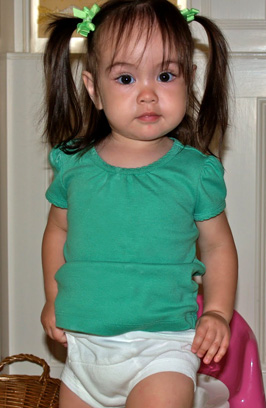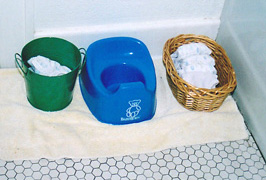Transitioning from Nappies to Pants
Creating an environment for a smooth transition
- Provide a child-sized toilet chair in the bathroom so your child starts to make the proper association between it and its function.
- Give your child access to clean underpants, preferably in a basket or cabinet near the small toilet chair.
- Provide a container with a small amount of water and a lid for wet pants.
- Have a child-sized mop or floor cloth available for cleaning the floor.
- Provide a stool to act as a low seat for changing underpants and to stand on to reach the sink to wash his hands.
- Provide access to a towel and a wash-cloth on a low towel bar or hook within easy reach for your child.
Involving your child in learning what to do
- When your baby starts to roll around on the changing table it is a signal that he is ready to switch to training pants that can be pulled on and off in an upright position.
- Now make sure you always change your child in the bathroom so the link between elimination, wet underpants and the bathroom is strengthened.
- Introduce the toilet chair now and invite your child to sit on it at regular intervals throughout the day.
- Between 12 and 18 months your child will start to feel the sensation of pressure that occurs right before elimination and this is the first step in getting to the toilet on time so you can introduce underpants.
- Involving your child in the processes of getting changed, by inviting him to put his own wet pants in the bucket and look for dry ones will help him to become more aware of the responses of his body and learn about going to the toilet.
- He will enjoy mopping the floor when he doesn’t quite make it to the toilet chair on time.
Allow time
- The transition from nappies to underpants happens much sooner and more easily when it is started earlier rather than later. It will still take time for your child to be completely dry and it helps to remember that every time he doesn’t make it there on time is just another feedback mechanism for the child.

